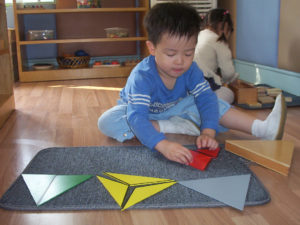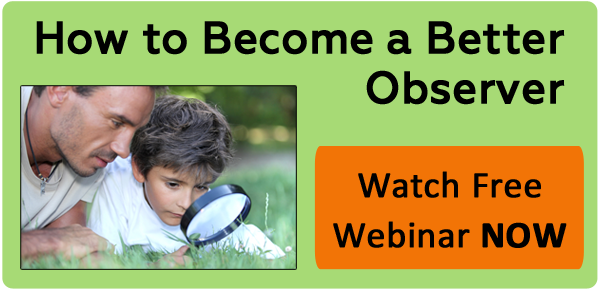
One of the key principles of Montessori philosophy is observing the child involved in a self-selected activity, which Dr. Montessori referred to as “work.”
To observe, we should make sure that the children we are observing have something interesting and meaningful to do. Plus, we need to target specific behaviors. Montessori teachers are trained to observe the child involved in the activities in an age specific prepared learning environment.
As we observe as Montessori guides, the two most important qualities we are looking for are the children’s displays of independence and concentration. The big lens through which we observe the children at work in their environment is focused on finding a child’s concentration on a self-selected task, along with a child’s ability to do that activity independently. We are looking for the child to grow bigger and bigger in these two qualities so that we, as the adult, can grow smaller and smaller.
As the Montessori adage goes: Any unnecessary help is a hindrance.
Observation also takes independence and concentration in the observer. To be effective in our watching, we need to be free of judgment, free of criticism, free of evaluation and free of psychoanalysis. When I begin an observation I bring to mind a favorite quote from Krishnamurti, “…the highest form of human intelligence is observing without evaluating.”
It is not easy to sit and suspend judgment on what you perceive to be happening.
Egos have to be moved out of the way, again and again, as it is easy to slip into the pattern of thinking that a child’s behavior is good or bad, productive or nonproductive, and on and on. We have to observe with the understanding that behaviors and emotions are need driven. Our observations become a search to help a child meet their developmental needs. Our watching is about the needs of the children, not about our adult needs or wishes. Our egos have no place in the observation equation. We observe to anticipate needs and respect the requests of the child to fulfill those needs.
Dr. Montessori wrote that when she was observing the children at work she was a “nobody.” I first understood this term, nobody, to mean that Dr. Montessori didn’t think of herself as Dr. Montessori, world famous child advocate, as she sat in an observation chair. After spending years observing, I think she meant she observed without the interference of ego, that she could observe without evaluating—the highest form of human intelligence. Being a nobody allows you to think very differently.
Observing in our Montessori classrooms—as either a teacher, or a parent—is not an activity to be taken lightly.
We need to be aware of the observer effect, that our presence can change the behavior of the children—especially our own child–as well as the classroom dynamics. We have to develop a cross-eyed technique of observation that makes us appear unobtrusive to the child. Does the child think we are looking at them or not? A slight glance can disturb the development of concentration and independence.
We have to learn to be systematic in our approach as that will give us clues to the children’s work and help us see connections that we might otherwise miss. We have to work every day at observing to be able to see the big picture of a child’s development. As teachers our daily observations are essential as they are the only way we can find out about children. 
As parents observing in a Montessori classroom, we should enter this children’s house as a “humble servant” seeking to understand the true nature of the child and the developing human being.
As parents we need to know that learning to effectively observe requires a giving up of ego and evaluations. Observation requires practice, practice that can be done in nature, perhaps watching a spider build a web, or at home watching “cross-eyed” as your child chooses a morning of activities.
As teachers we need to be observing constantly in the classroom environment. For parents of children in Montessori environments perhaps observing every few weeks will allow the passage of time to illuminate your child’s growth and help you see building concentration and independence, or uncover a developmental need.
With classroom observation we have to continually ask ourselves the question, “Why am I here?”
If the answer is something other than trying to understand the needs and requests of children, the children would be best served by your doing something else.
Sitting in a classroom watching children is not about the adult’s need to be amused, entertained, or occupied with problem solving. It is about understanding and serving the needs of children.
That’s the art of observation.
Additional reading:
Montessori, Maria. The Advanced Montessori Method-Volume 1, pages 53-97, Chapter 3: My Contribution to Experimental Science.

